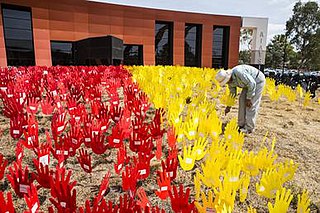This page is based on this
Wikipedia article Text is available under the
CC BY-SA 4.0 license; additional terms may apply.
Images, videos and audio are available under their respective licenses.

The Kabalbara also rendered Gabalbura and Gabulbarra, is an Australian aboriginal tribe of northern Queensland. No linguistic information has been recorded.
The Goeng or Goeng Goeng were an indigenous Australian tribe of the state of Queensland. They lived in the area of the area of present day Gladstone.
The Kokobujundji were an indigenous Australian people of the state of Queensland.
The Wongkadjera were an indigenous people of the state of Queensland.
The Gugu Rarmul were an indigenous Australian people of the state of Queensland, one of several whose speech was called Gugu Yawa.
The Laia were an indigenous Australian people of the state of Queensland.
The Lanima were an indigenous people of the state of Queensland.
The Pitapita or Pitta Pitta were an indigenous Australian people of the state of Queensland.
The Ringaringa (Ringu-Ringu) were an indigenous Australian people of the state of Queensland.
The Yanda were an indigenous Australian people of the state of Queensland.
The Wiknatanja were an indigenous Australian people, one of the Wik tribes of the Cape York Peninsula of northern Queensland.
The Wik Paach or Wikapatja were an indigenous Australian people of the Cape York Peninsula of northern Queensland.
The Rungarungawa were an indigenous Australian people of the state of Queensland.
The Julaolinja were an indigenous Australian people of the state of Queensland.
The Yilba, also written Ilba, were an indigenous Australian people of the state of Queensland.
The Kulumali were an indigenous Australian people of the state of Queensland.
The Kungkalenja (Kunkalanya) were an indigenous Australian people of the Channel Country in the state of Queensland.
The Kongabula were an indigenous Australian people of the state of Queensland.
The Kukatj were an indigenous Australian people of the state of Queensland. They are to be distinguished from the Kukatja, either the Northern Territory Loritja or the Western Australian Gugadja.
The Nguri were an indigenous Australian people of the state of Queensland.







